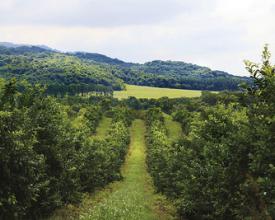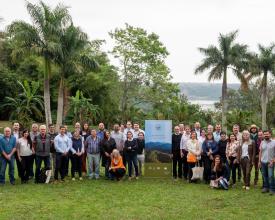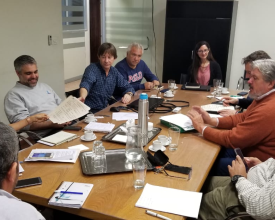
PROTECTED PRODUCTIVE LANDSCAPE (PPP*) bringing production closer to nature

In many developing countries, the expansion of the agricultural frontier and its effects on natural ecosystems have led societies to discuss the need for curbing the growth of production activities. This creates a paradox given that these countries, in turn, require more production to rebuild their national economy. In this respect, ProYungas Foundation has developed the concept of "Protected Productive Landscape", which derives from the Category V of the IUCN ("Protected Landscape"). But the novel part of this idea is that it puts production activities as the central point in the generation of economic, technical and political resources necessary for the preservation of the natural environment where these production activities take place. This concept places the production sector as the focal point of action, shifting it from the "problem side" to the "solution side". Currently, more than 300,000 hectares are being managed under this concept in critical ecosystems (Yungas and Chaco) in northern Argentina and Paraguay.
Context
Challenges addressed
In many countries, mainly developing countries, the expansion of the agricultural frontier and its effects on natural ecosystems have led societies to discuss the need for curbing the growth of production activities. This creates a paradox given that these countries, in turn, require more production to rebuild their national economy.
The COVID-19 pandemic combined with several natural disasters increase this difficulty, creating greater conflict between production activities and the preservation of nature. People from various sectors assure that this pandemic has its origin in human pressure on natural systems, and set out the need for a different, more proactive and more "healthy or sustainable" connection with nature. How can we improve, innovate and increase production activities -the economic engine of our countries-, and in turn make higher commitments to protect the natural capital necessary for our societies? That is the challenge!
Location
Process
Summary of the process
Las 5 líneas de acción interactúan naturalmente entre sí y van evolucionando en forma paralela e independiente, a excepción de la Planificación Territorial que es la base de todo el proceso. A medida que mejora la comunicación interna se van “empoderando” del proceso los actores del PPP, ello genera más compromiso y articulación entre sí. Esto va contribuyendo a mejorar la imagen interna de los procesos asociados a los distintos productos y ello va generando más exposición pública externa y, por lo tanto, más compromiso en ir mejorando las buenas prácticas en el marco de un proceso de mejora continua. En ese sentido, las 5 líneas de acción son vitales para llegar con éxito al concepto de PPP, que contribuya ciertamente a proteger los servicios ambientales que rodean al núcleo productivo y que ello sea valorado por la sociedad.
Building Blocks
1) Land-use Planning (baseline requirement).
This strand, the first to be developed, proposes to prepare a planning work that takes into account both production needs (current and future) and the context in which they are carried out. It requires visualization, through field and cabinet work (development of a GIS), of the characteristics of the landscape where the production is developed :environmental units, water basins, sectors under production, actual or planned infrastructure, critical or interesting habitats for nature conservation, topography, environmental and social environment of the property, local demographic pressures, connection of the territory with the categories of the Land-use Planning of Native Forests of the Province (OTBN for Argentina), other land-use regulations, etc.
Enabling factors
Having wild areas within the property and connected to other neighboring wild areas. Also, the willingness and openness of the owner/s for planning their territory in a consensual way.
Lesson learned
From these first 10 years of experience applying the PPP concept in different territories in northern Argentina and Paraguay, we have several lessons learned: a) the need to identify valid stakeholders and to generate bonds of trust with them; b) to clearly identify the environmental values that are primarily to be protected; c) to interpret the genuine needs for productive growth; d) the need to build a relationship between "partners" rather than "service providers"; and the willingness to accompany and/or face the public jointly.
2) Incorporating processes of continuous improvement in environmental performance.
This strand suggests focusing on internal production and operation processes, to identify phases or critical stages from an environmental point of view, that would enable the incorporation of improvements in the socio-environmental performance, always within a framework of continuous improvement. It involves aspects of production processes such as waste management, effluents and emissions, management of natural resources (soil, water), rational management of agrochemicals, infrastructure design, etc. An important aspect -that the program tries to promote- is the inclusion of certifications (local, national or international). These are valid tools that allow organizations/companies/cooperatives not only to achieve better environmental standards but also to incorporate additional value to their products while maintaining or adding markets for them.
Enabling factors
Having experience in processes of continuous improvement, a routine habit of measuring and generating information about the processes and a market demand for safe and responsible products.
Lesson learned
From these first 10 years of experience applying the PPP concept in different territories in northern Argentina and Paraguay, we have several lessons learned: a) the need to identify valid stakeholders and to generate bonds of trust with them; b) to clearly identify the environmental values that are primarily to be protected; c) to interpret the genuine needs for productive growth; d) the need to build a relationship between "partners" rather than "service providers"; and the willingness to accompany and/or face the public jointly.
3- Biodiversity Monitoring
Monitoring is the sustained study of certain environmental indicators (flora, fauna, water resources, etc.) in order to establish a baseline that facilitates tracking the behavior of the environment in relation to the production systems. This information allows for implementing improvement measures in aspects related to land management while strengthening positive actions and mitigating, through corrective actions, components that may be unfavorable in the production-natural environment relationship.
Enabling factors
Having a technical team nearby, with technical capacities to generate reliable monitoring and surveys. Also, the presence of certain “emblematic” species that generate empathy on the part of the property owners.
Lesson learned
1- Monitoring mammals with camera traps plays a key role in developing empathy, on the part of producers, towards species that inhabit their territory.
2- Biodiversity monitoring cannot be an end in itself. It has to help solve a problem, it has to serve to change a reality, and for that it is very important to establish a baseline with sufficient data. Undoubtedly, monitoring is particularly useful to evaluate the efficiency of corrective measures in specific situations. One example is the evaluation and search for a favorable solution to irrigation channels.
4. Internal and external communication.
Communication enables an understanding of the objectives and the actions that have been taken to achieve adoption of the principles that sustain the program, by all the members of the organization and the local community. It is a way to highlight the effort made and the policies implemented in order to ensure the sustainability of the productive processes. Communication within the organization allows dissemination of the vision, values and actions put in place to improve environmental performance, the commitment to the community and the quality of the products offered External communication specifically allows dissemination of the organization's efforts to improve its productive and environmental performance to the local community, buyers, suppliers and any other social actor relevant to their interests.
Enabling factors
Having smooth internal communication mechanisms between the company and the staff; and the presence of external local/regional media interested in production/environment topics.
Lesson learned
1- Due to internal communication, employees develop a sense of appreciation and commitment towards the actions carried out by the company, which are then transferred to their family and social environments.
2- The alliance between the company and civil society in communication matters, increases the credibility of messages, especially if the communication comes from civil society.
3- The positive response of people to communication processes increases trust in what has been done and the company's commitment.
4- Build strategic alliances with different territorial stakeholders.
Creating working relations involving all sectors of society (private, government organizations and civil society organizations) helps to strengthen and authenticate the efforts made under the Program. This also encourages dialog that facilitates the opportunity to lead or resolve conflicts that arise from the production activity, within a framework of respect and tolerance, recognizing that in a territory there are different visions and interests, and all must be fairly considered. Alliances promote synergies that enhance individual efforts and active participation of all sectors of society. They enable the creation of an idea of territory, of collaborative planning, promoting more equitable power relations and the generation of a common vision between actors that were traditionally disconnected or even antagonistic to one another, although they shared the same limitations and potentialities. Within the framework of the Program, alliances put emphasis on the socio-environmental aspects of the territory, which are often disregarded from a perspective exclusively focused on production.
Enabling factors
Having preexisting relationships with other companies, communities or organizations with which they share the territory, and the existence of common goods (access roads, water availability, control of illegal activities).
Lesson learned
1- These alliances are key for building a notion of territory with multiple stakeholders and interests, that enables to promote other activities independently from the area of action of companies.
2- A good management of alliances enables to minimize and even eliminate possible unforeseen conflicts.
Impacts
Up to this point, seven (7) companies have adopted this model (a sugar mill, three (3) citrus companies, a small-scale cattle producers association, a farming and agricultural cooperative and 5 cattle producers grouped together). And there are seven (7) NGOs which are partners of the program (ProYungas, TNC, WCS, Moisés Bertoni Foundation, Hábitat y Desarrollo, FCBC, AAPRESID). This encompasses three ecoregions (Yungas, Chaco Seco and Chaco Húmedo), almost 150,000 ha of wild land, some 37 species of large and medium-sized mammals, and more than 250 species of birds. Among the products produced in these areas, we can mention sugar, alcohol, paper, citrus fruits (oranges, tangerines, lemons), beef and dairy products.
Beneficiaries
The beneficiaries are the companies, cooperatives or producer associations that can associate their products with specific actions to protect nature.
Also, communities benefit from the regional environmental services.
Sustainable Development Goals
Story

In 2000, with the arrival of soybean in Argentina, the deforestation rate went from tens of thousands of hectares to more than 200,000 ha/year. This expansion first occurred on lands already used for farming or livestock production. Later on, soybean crops spread to subtropical wild ecosystems of high environmental value in northern Argentina. In this context, the main sugar mill in Argentina, the Ledesma agribusiness complex located in the province of Jujuy, presented an environmental impact study (approved by the competent authority) to expand 1000 hectares of the sugar cane area. Even though this number is marginal compared to the total agricultural area of the country (500,000 ha of sugar cane in 37.5 million agricultural hectares), environmental organizations focused their attention on this company (which does not grow soybean) to highlight the problem of deforestation.
Due to our territorial involvement in northwestern Argentina, where the mill is located, we were invited by environmental organizations to technically “explain” to the company the reasons of the legal actions they were taking against them. From this new relationship between a large company and an environmental CSO, we came up with a proposal to make a land-use planning of the 150,000 ha (50,000 hectares in production + 100,000 wild hectares) owned by Ledesma. With this plan, the company moved forward with the expansion project, with the formal commitment to privately protect the 100,000 wild hectares (rain forests and wetlands). We later on called this experience of territorial planning at a property scale “Protected Productive Landscape”. Subsequently, environmental organizations suggested the convenience of transferring this initiative to the rest of the forested area of Jujuy (around 1.1 million ha); a proposal that was accepted by the provincial government assuming that these processes are necessary and imperative.
The experience was then transferred to a national scale through a Law of Minimum Budgets for Environmental Protection of Native Forests (Law No 26,331), reaching all of Argentina's native forests over an area of about 30 million hectares. This mandatory land-use planning of native forest involved zoning the forests into categories. Voluntarily and partly motivated by the enactment of this law, a group of companies, mainly from the citrus and forestry sector, joined the PPP concept, involving an additional 300,000 hectares, in the provinces of Tucumán, Salta and Misiones.
















